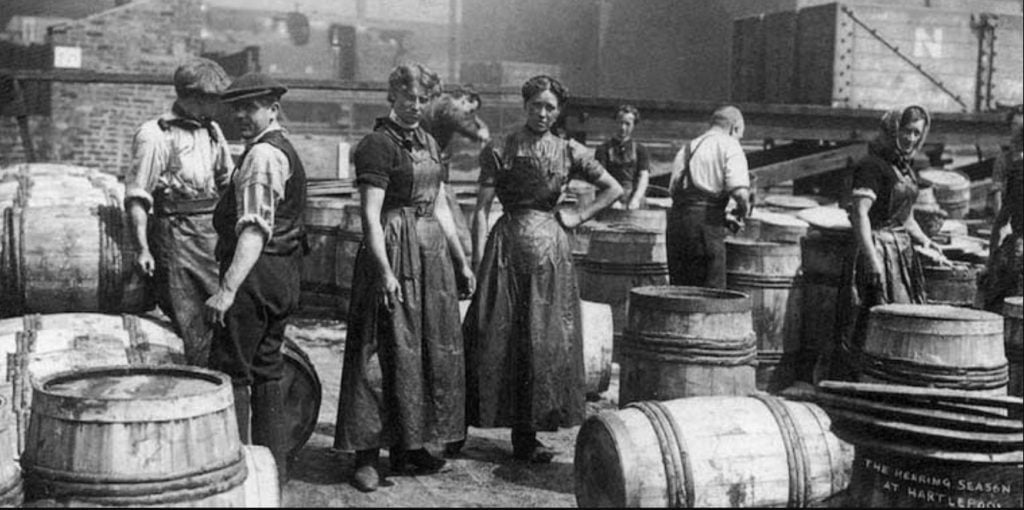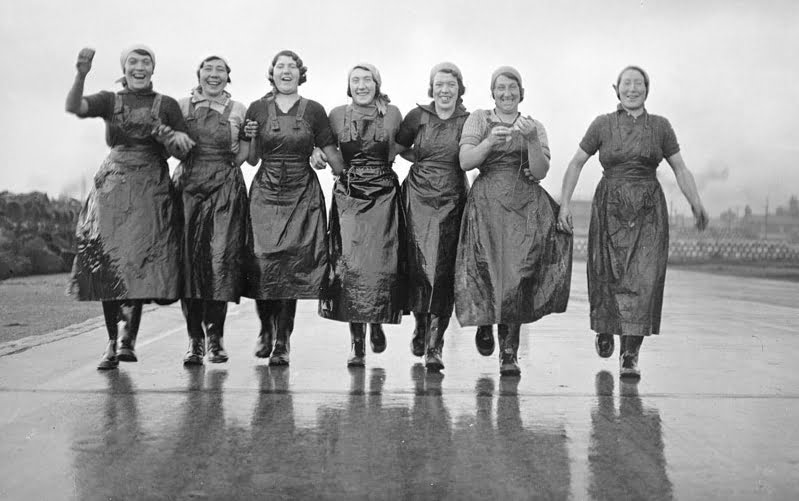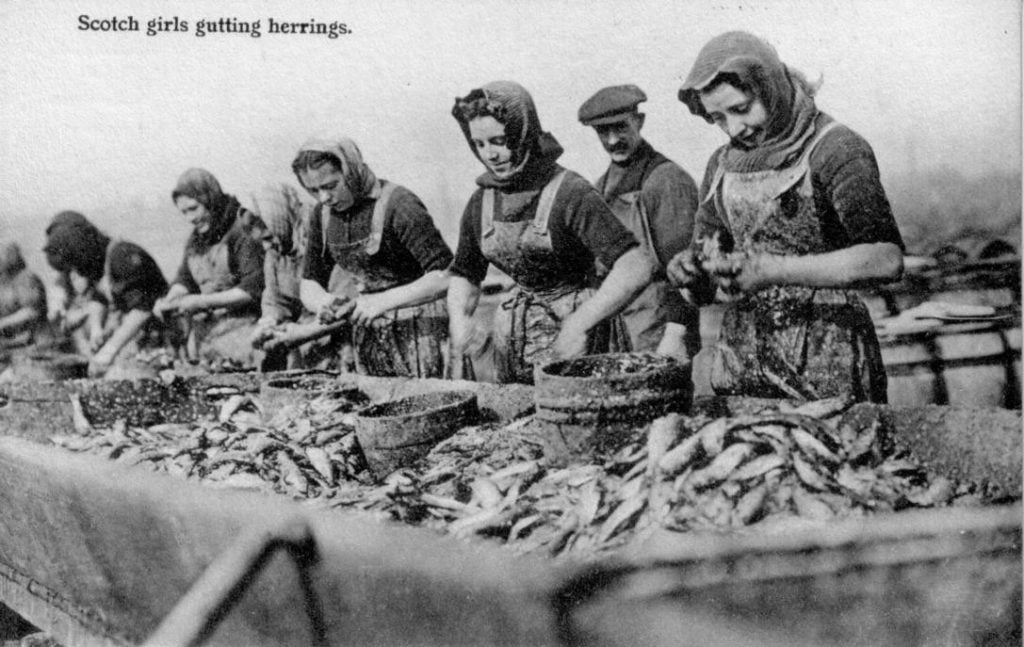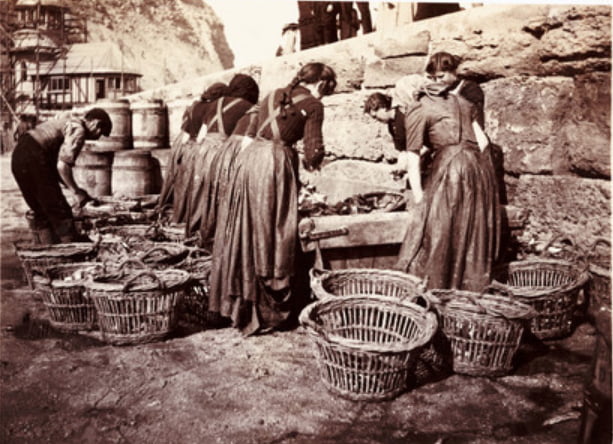On the herring lasses and the work they did, following the fishing around the coast of Britain, but particularly from Shetland to Great Yarmouth
HERRING LASSES
Herring lasses, fisher lasses, herring girls, the gutters and packers who worked the herring seasons around the coasts of Britain and Ireland. From early teens to grandmothers in their seventies, never herring women. And it was the same from the North of Iceland to the Eastern Baltic.

Fishwives and fishlasses were different, even when they might have been the same women: the sellers of fresh or ‘caller’ herring could be considered exemplars of a strong and independent minded beauty in their youth, but became proverbially coarser the older they got.
The White Herring Trade
Overwhelmingly, the work of the herring lasses was concerned with white or salt-pickled herring. As a significant international trade it certainly goes back to the Skåne fishery, developed in the late C12th by the Danes, taken over by Lübeck and the German Hanse, which controlled the supply of salt.
In the C14th the Dutch improved the cure – removing the gills and the long gut; salting at sea – and in fairly short order took the trade. The English and the Scots took painfully long to catch up, but eventually the Dutch Cure was rebranded as the Scotch Cure in the C18th and the UK dominated the huge Central and Eastern European markets from the C19th to World War I.
The seasonal nature of the work initially just drew women from each herring port and its surrounds. The sequences of herring seasons around the coasts of the UK and Ireland combined, however, with the growth of the railways and allowed an expansion of Scottish herring curing operations. The railways also enabled the more extensive travel of the skilled workforce on which the curers relied.
The main sequence started in May in Shetland and moved down the East Coast of Scotland, to the Tyne, to the Yorkshire Coast and to Great Yarmouth and Lowestoft where it finished in December. Depending on the fishing, some continued into the New Year down the coast of the English Channel. There were variations on the route that took in the West Coast of Scotland and Ardglass in Ireland.
The dominance of the Scotch cure and Scottish curers, the lack of reasonably paid alternative employment, earlier seasons and homeground identification of gutting skills: all of these factors contributed to the emergence of the Scots as the workforce for the industry. It wasn’t exclusive, but by the early C20th most herring ports looked to the annual ‘invasion of the Scottish herring lasses’.

Brawn and Brains
The phenomenon of the migrant workforce grew from the mid C19th as the Scotch cure and the Scottish herring fleet conquered the European markets, but it was built on a tradition of strong and independent women.
In her article, A Partnership of Equals: Women in Scottish East Coast Fishing Communities (1992), Margaret King describes a culture which placed a high value on a woman’s physical strength and her skills in financial management.
With beach launches a wife would carry her man to and from the boat to avoid the dangers of wet clothes. She took major responsibilities for the business side of things, as well as baiting the lines, carrying ballast and whatever else was required. If these functions were not covered within a family they had to be paid for.
The sense of independence that enabled this large scale female migration was already there before the curers needed it. But following the fishing also began earlier. In the early C19th, when many of the fishermen were still working out of undecked boats, the wives would go with them as they went further and further afield, staying onshore in tents, huts and bothies to cook hot meals and help with the gutting when the catches came in.
Gutting and packing herring required skill, speed and stamina. As the scale of operations increased, the curers drew on this existing culture in developing a seasonal migrant labour model.
The Work

The herring lasses worked in teams of three: two gutters and a packer. Members of the same family or friends, they would tend to come from the same community. Off season, for a fee (earlas in Gaelic, airleas or arles – a pledge) they would sign with a curer for the next one.
Everything they needed was packed into a kist – a wooden trunk or box that was loaded on to the train or boat transporting them to each destination.
The work was hard and, unless the fishing was poor, long. 6am to 6pm was standard. Carrying on until 9pm was regular. It was not unusual to work until the early hours of the morning.
There was an allowance for food and in most ports they were provided with basic accommodation. In East Anglia they were paid an allowance for lodgings – after their summer visitors had gone, landladies would strip out the rooms and cover the walls against the herring scales, guts and pervasive smell.
Some jobs were on an hourly rate, but the gutting and packing was piece work – a payment at the end of the season for all the barrels passed by the inspectors and the buyers. A higher rate was paid for gutting than packing, although many teams chose to share the money equally.
Before World War I, interviewed by David Butcher for Following the Fishing (1987) Annie Watt, originally from Peterhead, remembered being paid 8 shillings a week for food and lodgings and 8 pence a barrel.
In a memorably good fishing week at Gorleston she remembered her team gutting and packing 288 barrels between the Tuesday and the Friday (around £750 to split between the three in the team). A barrel took between 900 and 1,200 herrings, depending on the size of the fish.
The gutters worked at long troughs called farlins or farlans and had to sort the herring by size and quality. In Scotland there were seven categories – Large Full (not less than 11¼” or 28.5cm, full of milt or roe), Full (not less than 10¼” or 26cm, milt / roe), Large Spent (10″, post-spawning), Filling (10¼”, maturing), Medium (9½”, maturing), Matfull (9¼”, milt / roe), Mattie (9″ young maturing).
There were fewer categories in East Anglia, which speeded the work up, although the herrings were mostly smaller, so it took more gutting to fill a barrel.
It took until 1918 for the curers to sort out lifting the farlins to a more easily operational height, avoiding the back-breaking requirement of picking the fish up from shin level.

Salt was scattered on the herrings as they were tipped into the farlins, obviously helping with the preservation, but as importantly making it easier for the lasses to pick them up.
A short, sharp knife known as a futtle was used, the gutting and removal of the gills done in one deft movement, each fish taking around one second to gut and put in the tub for the appropriate category.
It was best if the team’s packer was tall, as she had to bend right down to the bottom of a barrel to lay the first layer of herrings – belly up and tightly packed. The bottom and top layers were crucially important as inspections didn’t always go deeper.
The filled barrels were left for a few days to pine – the herrings shrinking in the brine. This salt pickle was drained off, but kept – the flavour it had acquired was crucial. The barrels were topped up with new layers of herrings and the pickle poured back in, before the lid was put back on.
The sharpness of the futtles and the speed of the work meant accidents were common. The constant contact with salt made even the slightest wound really painful.
The first line of defence were the cloots or clooties – strips of cotton, usually from flour bags, which were tied around each finger at the beginning of the day (Get up an’ tie yer fingers, was a standard wake up call). Left handers tended to get put on packing as it was safer if the gutters were all right handed.
The Red Cross and assorted church and women’s organisations provided first aid stations – blood poisoning signalled the end of a lass’ season. Rubber gloves came in just before World War II.
The lasses covered their hair to stop the herring muck getting into it. They wore long oilskin aprons and the rubber boots which replaced the leather ones of the early days.
The Scottish curers and the Scottish fleet didn’t work on Sundays. When there was any spare time, the herring lasses would knit.
Bolsheviks
The Transport & General Workers Union organised the herring lasses after World War I and there were several strikes. They were usually successful, because no one could afford to leave the herrings to rot on the quayside.
Like their sisters, Iceland’s sildarstülka, who also went on strike successfully, it was hard to argue too much with the long hours – to achieve the Crown brand mark of quality the herrings had to be cured on the day of the catch (even when technically it might have been 3 o’ clock the next morning). They fought to up the barrel rate or the hourly rates and they fought for improved conditions (a roof over the gutting farlins, for example, or just three lasses sleeping in each hut).
In Susan Telford’s ‘In a World a Wir Ane’: A Shetland Herring Girl’s Story (1998) the author’s grandmother, Christina Jackman (née Leask) talks of a strike in Lerwick over the hourly rate for shifting the barrels and salt that came in on the stock boat:
We only got fower pence an oor first, working da stock boats, an dan we gied on strike for six pence. We gied on strike whan da stock boats cam in. Wir boss called wiz da Bolsheviks, an aa da names he could lay his hands on. We worked wi Bloomfields aa da time. Dey called wiz aathing, but we got it just da sam. Dey hed ta pay wiz tuppence because we stuck together. It was early ida twinties, somewye.
Christina Jackman also describes a slightly more enforced solidarity in Yarmouth in the 1930s:
Wan year we gied on strike. We got fifteen an six shillings a week, an aabody gied on strike to get anidder half-a-crown onta wir wages. In Yarmouth dey wir dis tree women, an dey gied round aa da yards, aa da fishing yards, an took oot aa da women. God help dem at didna come oot. Dey wir nae black legs in dem days. Naebody dared geng back ta work, because dey wid be mauled. We wir frightened o dem because dey wir huge. Dey took aabody oot on strike… Da strike only lasted tree days. We just walked up an doon da river at Yarmouth. Dan, ida end da curers hed ta gie in because dey wir so much herring. We got half-a-crown, so dat brought wiz up ta seevinteen shillings. But we needna bothered because da landlady pat up wir rent a shilling, so whit we got wis only wan an six pense ida end.
The End
The way of life of the herring lasses declined with the industry. In 1920 there were 9,000 migrant herring lasses, by 1938 4,500. By 1962 there were only 10 Scottish women working the Yarmouth season.
Books & Articles
Dear Gremista: the Story of Nairn Fisher Girls at the Gutting by Margaret Bochel, 1979
Following the Fishing by David Butcher, 1987
A Partnership of Equals: Women in Scottish East Coast Fishing Communities by Margaret H King, 1992 (article in Folk Life, 31:1, 17-35)
‘In A World A Wir Ane’: A Shetland Herring Girl’s Story by Susan Telford, 1998
Doon to Lerwick and up to Yarmouth: the Working and Living Conditions of the Scottish Herring Lasses c. 1860 – 1960 by Kate Newland, 1999 (article, Stavanger Museums)
External Links
See also
- BRITISH FISHERY
- CALLER HERRIN’ (FILM)
- CALLER HERRIN’ (SONG)
- DIVINE PROVIDENCE
- DRIFT OR GILL NETTING
- DRIFTERS (DOCUMENTARY FILM)
- DUTCH GRAND FISHERY
- HERRING INDUSTRY BOARD
- HERRING’S HEAD
- ICELANDIC FISHERY
- IDDIKETTS OR IDDIS
- MIGRATION & MOVEMENT
- MUIR, JIM (HERRING INTERVIEW, ACHILTIBUIE)
- SALT
- SINGING THE FISHING
- SUFFERING SALTWORKERS OF SHIELDS
- WHITE HERRING
- WHEN HERRINGS LIVED ON DRY LAND
- WILLIAMS, WILLIAM CARLOS: FISH
- WITCHCRAFT
